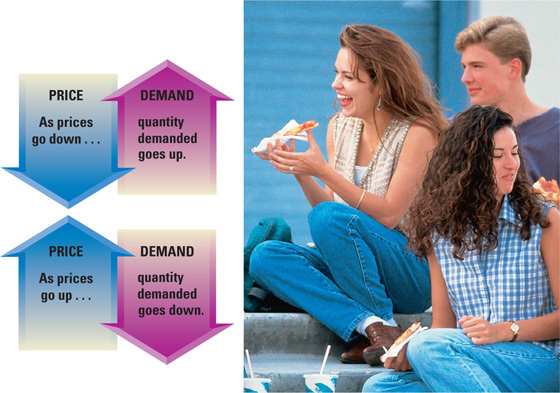Section 1 Understanding Demand
Preview
Objectives
After studying this section you will be able to:
- Explain the law of demand.
- Understand how the substitution effect and the income effect influence decisions.
- Create a demand schedule for an individual and a market.
- Interpret a demand graph using demand schedules.
Section Focus
According to the law of demand, people buy less of a good when its price rises. Demand schedules and demand curves illustrate how people and markets react to different prices.
Key Terms
- demand
- law of demand
- substitution effect
- income effect
- demand schedule
- market demand schedule
- demand curve
In Chapter 2, you read about economic systems, which are different ways of answering the three economic questions of what to produce, how much to produce, and who gets what. In the United States, most goods are allocated through a market system. In a market system, the interaction of buyers and sellers determines the prices of most goods as well as what quantity of a good will be produced. Buyers demand goods, sellers supply those goods, and the interactions between the two groups lead to an agreement on the price and the quantity traded.
Demand is the desire to own something and the ability to pay for it. We will look at the demand side of markets in this chapter. In the next chapter we will look at the actions of sellers, which economists call the supply side. In Chapter 6, we will look at supply and demand together and study how they interact to establish the prices that we pay for most goods.
The Law of Demand
Anyone who has ever spent money will easily understand the law of demand. The law of demand says that when a good's price is lower, consumers will buy more of it. When the price is higher, consumers will buy less of it. All of us act out this law of demand in our everyday purchasing decisions. Whether your income is $10 or $10 million, the price of a good will strongly influence your decision to buy.
Ask yourself this question: Would you buy a slice of pizza for lunch if it cost $1? Many of us would, and some of us might even buy more than one slice. But would you buy the same slice of pizza if it cost $2? Fewer of us would buy it at that price. Even real pizza lovers might reduce their consumption from 3 or 4 slices to just 1 or 2. How many of us would buy a slice for $10? Probably very few. As the price of pizza gets higher and higher, fewer of us are willing to buy it. That is the law of demand in action.

Figure 4.1 Law of Demand




